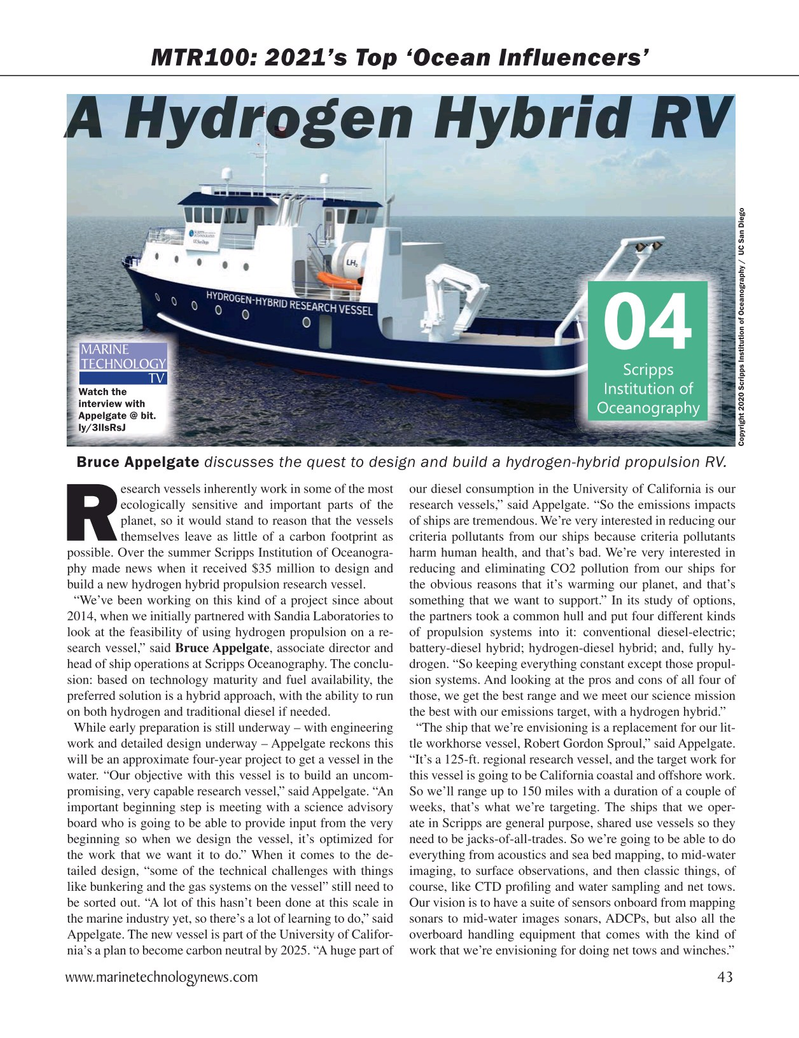
Page 43: of Marine Technology Magazine (September 2021)
MTR100: Focus on 100 Leading Companies, People and Innovations in the Subsea Space
Read this page in Pdf, Flash or Html5 edition of September 2021 Marine Technology Magazine
MTR100: 2021’s Top ‘Ocean Influencers’
A 04
MARINE
TECHNOLOGY
Scripps
TV
Institution of
Watch the interview with
Oceanography
Appelgate @ bit.
ly/3lIsRsJ
Copyright 2020 Scripps Institution of Oceanography / UC San Diego
Bruce Appelgate discusses the quest to design and build a hydrogen-hybrid propulsion RV.
esearch vessels inherently work in some of the most our diesel consumption in the University of California is our ecologically sensitive and important parts of the research vessels,” said Appelgate. “So the emissions impacts planet, so it would stand to reason that the vessels of ships are tremendous. We’re very interested in reducing our
Rthemselves leave as little of a carbon footprint as criteria pollutants from our ships because criteria pollutants possible. Over the summer Scripps Institution of Oceanogra- harm human health, and that’s bad. We’re very interested in phy made news when it received $35 million to design and reducing and eliminating CO2 pollution from our ships for build a new hydrogen hybrid propulsion research vessel. the obvious reasons that it’s warming our planet, and that’s “We’ve been working on this kind of a project since about something that we want to support.” In its study of options, 2014, when we initially partnered with Sandia Laboratories to the partners took a common hull and put four different kinds look at the feasibility of using hydrogen propulsion on a re- of propulsion systems into it: conventional diesel-electric; search vessel,” said Bruce Appelgate, associate director and battery-diesel hybrid; hydrogen-diesel hybrid; and, fully hy- head of ship operations at Scripps Oceanography. The conclu- drogen. “So keeping everything constant except those propul- sion: based on technology maturity and fuel availability, the sion systems. And looking at the pros and cons of all four of preferred solution is a hybrid approach, with the ability to run those, we get the best range and we meet our science mission on both hydrogen and traditional diesel if needed. the best with our emissions target, with a hydrogen hybrid.”
While early preparation is still underway – with engineering “The ship that we’re envisioning is a replacement for our lit- work and detailed design underway – Appelgate reckons this tle workhorse vessel, Robert Gordon Sproul,” said Appelgate. will be an approximate four-year project to get a vessel in the “It’s a 125-ft. regional research vessel, and the target work for water. “Our objective with this vessel is to build an uncom- this vessel is going to be California coastal and offshore work. promising, very capable research vessel,” said Appelgate. “An So we’ll range up to 150 miles with a duration of a couple of important beginning step is meeting with a science advisory weeks, that’s what we’re targeting. The ships that we oper- board who is going to be able to provide input from the very ate in Scripps are general purpose, shared use vessels so they beginning so when we design the vessel, it’s optimized for need to be jacks-of-all-trades. So we’re going to be able to do the work that we want it to do.” When it comes to the de- everything from acoustics and sea bed mapping, to mid-water tailed design, “some of the technical challenges with things imaging, to surface observations, and then classic things, of like bunkering and the gas systems on the vessel” still need to course, like CTD pro? ling and water sampling and net tows. be sorted out. “A lot of this hasn’t been done at this scale in Our vision is to have a suite of sensors onboard from mapping the marine industry yet, so there’s a lot of learning to do,” said sonars to mid-water images sonars, ADCPs, but also all the
Appelgate. The new vessel is part of the University of Califor- overboard handling equipment that comes with the kind of nia’s a plan to become carbon neutral by 2025. “A huge part of work that we’re envisioning for doing net tows and winches.” www.marinetechnologynews.com 43
MTR #7 (34-49).indd 43 9/22/2021 2:25:39 PM

 42
42

 44
44
